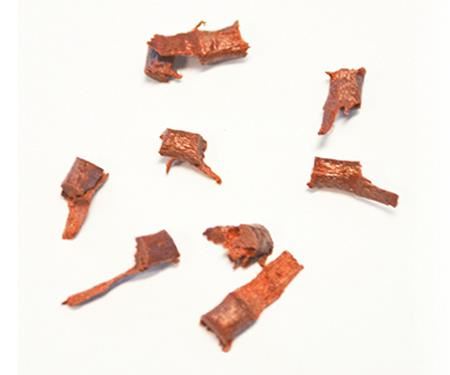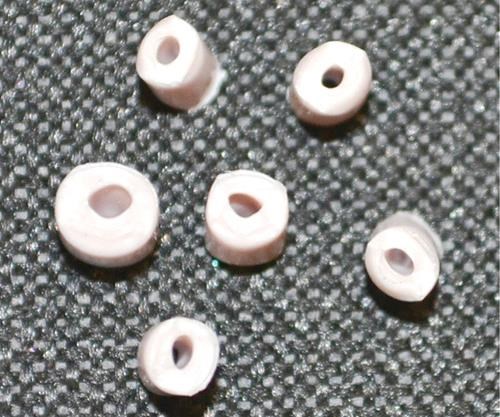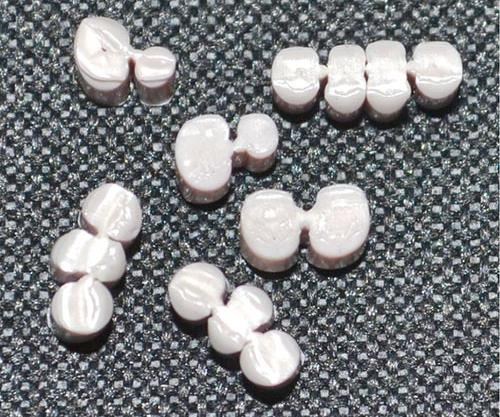Solve Seven Common Pelletizing Problems
Troubleshooting: Pelletizing
Here's a quick how-to on keeping your pelletizing line churning out quality product.
Plastic pellets are typically aspirin-shaped and produced on a die-face cutter, or right-angle cylinders manufactured on a strand line. Either way, they are the preferred material choice for injection molders, profile extruders, and compounders that reintroduce reclaimed scrap into virgin processes.
Dozens of pelletizing technologies are available today targeting a host of processes, such as high-output polymerization/finishing lines, dedicated high-output and small-batch custom compounding, concentrate and micro-pellet production, and reclaim.
Of these technologies, two stand out for satisfying the broadest range of processor needs: strand pelletizers, which also include automatic strand-management designs; and die-face cutters, which encompass both underwater and water-ring designs. Each technology offers a unique set of features and benefits suited to particular process needs. Each process also has its own set of challenges and problems that require a certain level of expertise and understanding … and sometimes special attention.
UNDERSTAND YOUR PELLETIZING OPTIONS
Conventional strand pelletizers are among the oldest types of pelletizers and are generally considered to be the simplest. They are used on a broad range of polymers typified by high melt strength and resistance to breakage. Resin manufacturers and compounders can process the widest range of materials on these systems—everything from unfilled olefinics to engineering resins filled up to 90% by weight. The pellets are cylindrically shaped with right-angle edges and have a good degree of uniformity.
Along with their broad utility, these types of pelletizers represent the largest installed base. In these systems, molten polymer is extruded through a series of die holes and formed into strands that drop into a water bath to be quenched and then pass through an air knife and into the pelletizer. Bath residence time is determined by the cooling characteristics of the polymer.
Machine designs have been refined over the years to significantly reduce maintenance and labor for cleanout. Tool-less entry; cutter disassembly in less than 2 min; long-wearing bed knives with four usable edges; eccentric knife adjustments; and wear-resistant, low-deflection rotors are but a few of the features offered on newer models.
Meanwhile, underwater pelletizer technology has evolved significantly over the past 30 years and has become a significant choice in reactor discharge, polymer finishing, compounding, and most notably, recycling. From an operational viewpoint, startup of these systems is arguably the most complex of all pelletizers. However, once up and running, performance is generally unattended unless the line is stopped or production is disrupted. In either case, as well as for startup, sophisticated PLC-based control systems are available to automate the process and provide alarms.
Upon startup, pressurized process water is pumped into a pellet chamber that is joined to the die plate. A cutter-shaft assembly transiting the chamber spins a knife hub over the die face. Polymer strands extruding through the holes are cut into uniform-length pellets by the passing blades. The pellets are instantly jacketed and cooled and then conveyed into an overhead transfer pipe for added cooling time. The pelletizer operates as a closed-loop system free of air. Upon exiting the transfer pipe, the slurry empties into a centrifugal dryer, where the separated water flows into a circulating tank. Pellets are conveyed through the dryer by lifter vanes and are discharged to a collection bin.
One underwater system utilizes a patented die technology to make the system insensitive to melt-flow interruptions and startup issues encountered with other manufacturers. Whether during startup or processing, the die technology eliminates the need for a water bypass found on other machines, and greatly simplifies the operator’s interaction with the equipment.
Both strand and underwater pelletizing presents some unique challenges to resin manufacturers, compounders, and reclaim operations, including the following set of commonly encountered considerations.
DEALING WITH FINES
Fines are seemingly endemic to many crystalline materials such as general-purpose polystyrene. They are an issue for processors because they can alter the bulk density of materials, degrade or burn in the barrel of an extruder, and present a nuisance in conveying. The primary objective for resin producers is to produce consistent pellet geometries to a target length and diameter with no contamination from fines or foreign material.
Fines can be reduced by controlling a few machine adjustments and one very important process parameter. The temperature of the strand line should be as close to the Vicat softening point of the material as possible when entering the cutter. This ensures that the strand is being cut as hot as possible to avoid fracture.
Selecting the correct rotor with a suitable cutting angle for the particular polymer is of vital importance in minimizing fines during processing. Use Stellite or tool-steel rotors for unfilled polymers wherever possible. Maintain a keen edge on rotor and bed knives to avoid shattering the polymer. The post-cut apparatus, whether pressurized or vacuum, should avoid entrained air.
For underwater lines, be sure to maintain sufficient knife pressure against the die face during the process. Regulate the residence time of the post-cut pellet to ensure the pellets are warm when entering the dryer.
SOLVING TAILS
A tail is a little protrusion on the edge of a pellet and resembles the shape of a hockey stick on the cut edge. It looks like a smear or tear at the bottom of the cut where the cutting apparatus has failed to make a crisp, clean cut. A correctly cut pellet from a strand pelletizer should be a right-angle cylinder. A correctly cut pellet from an underwater pelletizer should be nearly a perfect sphere.
Tails produce fines in materials that normally are not susceptible to them. Assuming all process parameters check out, tails can be generally diagnosed as a cutting problem. For strand lines, swap the rotor to provide a fresh, keen cutting edge and change the bed knife to provide a fresh cutting edge. Another adjustment is re-gapping the machine to the value in the manufacturer’s manual. In underwater lines, inspect the die plate, because tails are often caused by nicks and grooves. Be sure to check each blade to ensure there are no nicks.
IMPROVING STRAND CONTROL
Jack straws are the same as “longs” and can range from longer than nominal pellet length to several inches. Jack straws (also known as angle cuts) are an indicator of poor strand control at the point where the strands are presented to the cutting rotor. A jack straw results from a strand being presented to the rotor in an attitude that is not perpendicular. Therefore, the ends will be angled when cut.
The distance between the feed rolls (the nip point) and the rotor (the cut point) is called the push distance, because there isn’t anything controlling the strand in that span. A pelletizer is not unlike a wood planer. If the feed rolls are misaligned or in poor condition, the plastic strands will not be presented to the cutting apparatus perpendicular to the cutting plane. The problem is exacerbated because the strands will start crossing over on top of each other, causing a further deterioration in cutting quality.
Crossing strands will force the feed rolls apart and the tension on the strands will be lost. As a result, the strands will momentarily drop, causing them to turn sideways. Ideal cutting occurs when the feed rolls are in good condition, the strands being extruded are the same diameter, and other process variables mentioned below are within normal limits.
Among the warning signals is an upper feed roll in poor condition with grooves, checks, or discoloration (hardened from age or heat). Other common problems include a worn lower feed roll, which causes loss of traction; an improper strand tempering process causing strands to snake wildly; and a worn stranding plate, which produces strands of various diameters. Manufacturers should also be aware of an extremely worn rotor and/or bed knife that actually resists the strand as it’s being pushed to the cut point. Also to be avoided is a cutter which runs at an excessive RPM for the diameter of the strand, causing it to wag.
In underwater systems, longs are in most cases produced by an imbalance of feed rate versus cutter speed. Increase the cutter speed to match the feed rate or decrease the feed rate to match the maximum cutter speed. Make sure that there are enough knives on the cutter head to ensure correct pellet geometry and check if any holes are slow moving or blocked from polymer flow.
STRAND MIGRATION
Strand migration is a condition whereby strands tend to bunch on one side of the feed table, resulting in diminished pellet quality, longs, and processing disturbances. If the pelletizer cutting plane is not parallel to the stranding plate of the die, the strands will tend to crowd right or left. Other causes of strand migration include inconsistent gap of the lower feed roll to the doctor blade, and inconsistent diameter of the lower feed roll.
AVOID SHRINK VOIDS
Shrink voids and hollow pellets are evidence of improper strand tempering. A shrink void can be as slight as a dimple on the end of a pellet or can be so severe that the pellet has a hollow core, much like a swizzle stick. The condition occurs when a strand has a core temperature near a molten state and contracts rapidly once cut.
Strands that are properly tempered have a consistent cross-sectional temperature gradient and have no response or reaction to a cooling medium (water or air) when cut. Shrink voids occur when process water is either too warm or too cold for the particular polymer, thus freezing the outer surface of the strand, creating a hard shell, and trapping heat in the core. In addition, there is insufficient soak time in the air or water to allow the core heat of the strand to migrate to the strand surface for good cross-sectional cooling.
Underwater pellets can also suffer this condition due to entrained volatiles in the melt. An important precaution is to check the vacuum port on the extruder.
PROCESS ADJUSTMENT FOR DOUBLES/ZIPPERS
Doubles or zippers are a series of pellets that are attached to each other, in some cases by a thin film of polymer, either end to end or tangentially. Several process-control issues can individually or collectively cause the problem.
The process water may be too hot. Lower the temperature to adequately quench the surface of the pellet. Another cause may be low water flow, which can contribute to pellets moving slowly out of the cutting chamber, resulting in agglomeration. If the die holes are too close together for the product, die swell may be creating contact between the pellets during the extrusion process. Replace the die with fewer holes at a larger spacing.
A CRACKED KNIFE CAN BE COSTLY
A bed knife is a solid piece of carbide in which Invar, a stainless-steel alloy, is brazed in place, making it possible to allow threads through which the carbide bed knife is mounted to a holder. A cracked bed knife typically occurs following rotation of the edge. Steps can be taken to avoid this by carefully following the recommendations in the manufacturer’s machine manual. It is often not understood that the Invar alloy plug containing the threads is held in place by silver solder and has a shear limit easily overcome by using too much torque when mounting. A bed knife cracked during rotation or installation can easily become dislodged and fly about in the pelletizer, destroying the cutting edges of the rotor and resulting in a very costly repair.
Read Next
See Recyclers Close the Loop on Trade Show Production Scrap at NPE2024
A collaboration between show organizer PLASTICS, recycler CPR and size reduction experts WEIMA and Conair recovered and recycled all production scrap at NPE2024.
Read MorePeople 4.0 – How to Get Buy-In from Your Staff for Industry 4.0 Systems
Implementing a production monitoring system as the foundation of a ‘smart factory’ is about integrating people with new technology as much as it is about integrating machines and computers. Here are tips from a company that has gone through the process.
Read MoreMaking the Circular Economy a Reality
Driven by brand owner demands and new worldwide legislation, the entire supply chain is working toward the shift to circularity, with some evidence the circular economy has already begun.
Read More




















